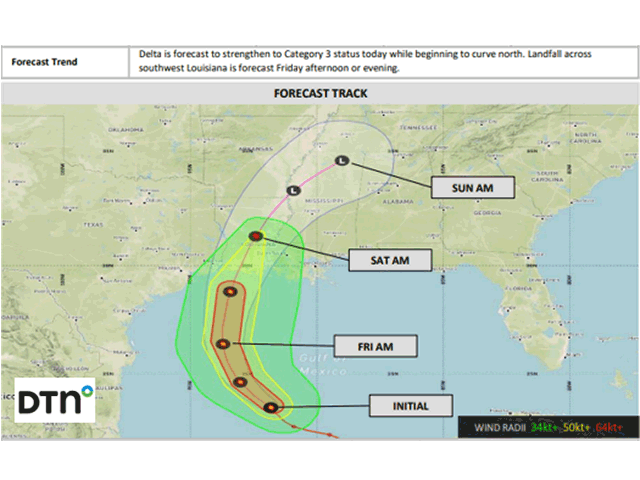Hurricane Aims for Delta
Mississippi Delta Braces for Another Hurricane as Cotton Bolls Open, Soybeans Await Harvest
MT. JULIET, Tenn. (DTN) -- Eastern Arkansas farmer Charles Williams has been battling wet weather for months. Hurricane Laura dropped 4 inches of rain in August, and now Williams -- who grows corn, soybean, cotton and rice -- expects another 2 to 4 inches from Hurricane Delta.
Williams hopes to finish rice harvest early Friday, and his corn crop is already in the bin. While those crops will miss the worst of Hurricane Delta, which is expected to make landfall as a Category 2 storm along the Louisiana coast late Friday, his cotton and soybeans aren't so lucky. He estimates 85% are still in the field.
"The most obvious risks are loss of yield and quality. Still some bolls opening. Hoping they don't headlock. Hoping they don't rot. Hoping no lint is knocked out. Hoping," he told DTN in an email.
Cotton harvest is running behind the five-year average pace in Arkansas, Mississippi and Louisiana, according to USDA's latest Crop Progress report, but the majority of bolls are open, exposing them to damage from wet, windy weather.
Delta is the third major hurricane to lash the nation's cotton crop in the last six weeks. It is expected to follow a similar track as Laura, the Category 4 storm that hit the coast in late August. Hurricane Sally made landfall near Gulf Shores, Alabama, in September before slowly creeping across the Southeast, dropping buckets of water on open bolls across the Florida Panhandle and Georgia's prime growing regions.
P[L1] D[0x0] M[300x250] OOP[F] ADUNIT[] T[]
"Fierce winds and heavy rains will likely zap much of the cotton crop Hurricane Sally had left behind," DTN Contributing Cotton Analyst Keith Brown said.
In early August, USDA estimated the U.S. cotton crop could reach 18 million bales. It lowered that estimate by nearly a million bales in September, and analysts anticipate USDA will make another cut in its Crop Production report on Friday. When combined with expectations for increased exports, the pressure on supplies have contributed to the highest December cotton futures price since August.
Soybeans also stand in the storm's path and could face quality issues. Louisiana farmers are the furthest along in their harvest, at 83% complete, while Mississippi growers only have 45% of the crop in the bin. Arkansas producers had harvested 27% of the crop as of Oct. 4, compared to the 42% five-year average.
"When you have a hurricane forecasted during harvest season, growers work extra hard to get as much of their crop out as possible before excess rain can cause damage to seed and make field conditions so wet that machine harvest becomes difficult," said Trent Irby, soybean specialist with the Mississippi State University Extension Service, in a news release.
The crop has been slow to mature this year amid cooler weather and rains from Tropical Storm Beta. "This time of year, the soil and plants won't dry out as fast as they do in August and September. Some fields could be difficult to get into until next year if we get a major rain event now," Irby said.
Rice harvest is about 70% complete in Arkansas and Mississippi, and while Louisiana growers are mostly finished with rice harvest, sugarcane harvest is just getting underway, at 12% complete statewide.
Chad Hanks, who farms near Lafayette, Louisiana, said he waited for Hurricane Sally to pass before beginning sugarcane harvest, which gave stalks blown over by Laura enough time to right themselves. In a news release from Louisiana State University's Ag Center, he said that he's concerned another storm will further complicate harvest. Lodged cane and wet fields make it harder for mills to extract sugar.
"We anticipate some mills might shut down before the storm," Hanks said, explaining that they shut down pre-emptively to prevent losing sugar from that cane that's waiting to be processed.
Hurricane Delta could also disrupt exports from ports in New Orleans and Baton Rouge at the busiest time of year. Soybean Transportation Coalition Executive Director Mike Steenhoek said 80% of soybean exports occur between September and February. USDA reported that 28 million bushels of soybeans and 24 mb of corn were exported from the lower Mississippi River just last week.
"This is clearly an important time for soybean exports, and the lower Mississippi River is clearly the leading port region," he said in an email. "As a result, the emergence of a hurricane that threatens the lower Mississippi River is worthy of concern and monitoring."
Katie Dehlinger can be reached at katie.dehlinger@dtn.com
Follow her on Twitter @KatieD_DTN
(c) Copyright 2020 DTN, LLC. All rights reserved.




